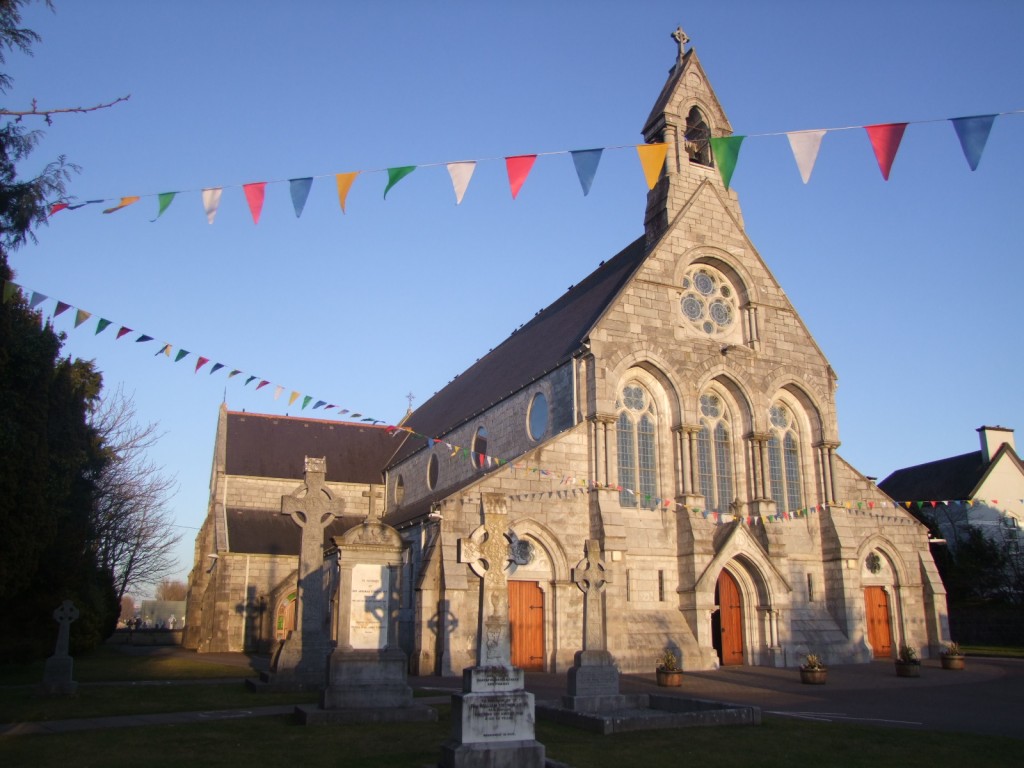
Kieran’s Our City, Our Town Article,
Cork Independent, 11 March 2010
In the Footsteps of St. Finbarre (Part 203)
Horgan’s Vision
In the 1860s there were 875 inhabitants in Ballincollig, with a large number of British soldiers with their families living in the town. With the creation and blossoming of the Ballincollig Gunpowder Mills came a need for housing and community services. Up to 1808, catholic families living in Ballincollig had to travel to Clash cross in Carriganarra, Ballinora or Kilnaglory to attend mass. The increase in the catholic population due to the building of the gunpowder mills made it apparent that the new church should be erected in Ballincollig. This new church became the parish church replacing Ballinora, which previously had the distinction.
The first church was commissioned in 1808 by Fr. Nicholas O’Riordan Parish Priest. The site was given by Charles Henry Leslie for 960 years at the rent of six pence per year. This man also donated 100 guineas towards the cost of building the church. The Bishop of Cork, Francis Moylan, was involved in the negotiations for the site. By 1860, the population of the parish of Ballincollig had grown so large that the 1808 chapel, which stood on the south side of the village, was unable to cope with the large attendances. Canon David Horgan, Parish Priest, started the interest in building a new church to accommodate the growing population.
After the closure of the church in 1866, the building was converted to a national school. The old church was replaced in 1866 with the Church of St Mary and St John. The new site was on higher ground less than 100 yards to the south of the old church. It was on the property of Thomas Wise who gave the site free of charge. He also very generously gave the use of a valuable quarry at his property in Coolroe, a short distance away, where all the stone was needed for the building could be got. The total cost was expected to be about £5,000, half of which had already been raised at that stage.
The 1866 church was built by Barry McMullen. It was designed by George Goldie who also was involved in the design of Church of the Immaculate Conception, Farran Church. George Goldie (1828 –1887) was a nineteenth century ecclesiastical architect who specialised in Roman Catholic churches. George Goldie was born in York in northern England. He trained as an architect with John Gray Weightman and Matthew Ellison Hadfield of Sheffield, from 1845 to 1850, and thereafter worked in partnership with the same pair. After Weightman left the partnership in 1858, Hadfield and Goldie remained in partnership a further two years. About this time, they designed Farran Church. George Goldie then practised alone until 1867 when Charles Edwin Child (1843-1911) joined him in partnership. In 1880 George’s Goldie’s son Edward (1856-1921) entered the partnership, having first been apprenticed in 1875.
George Goldie’s output included many churches in Britain and Ireland: St Mungo’s Church, Glasgow; Our Lady of Victories, Kensington in London (at the time of building, the Pro-Cathedral for the Archdiocese of Westminster); some of the interior furnishings of St John’s Cathedral, Salford including the reredos of 1853-5, together with the adjoining buildings now known as Cathedral House; and the churches of St Pancras, Ipswich, of 1861, St Vincent’s, Sheffield of 1856 and St Mary & St Augustine, Stamford of 1864/5. In Ireland, after building Ballincollig, George Goldie engaged in the design of several buildings: St. Mary’s Church Clonmel in 1867, St. Vincent’s Monastery adjoining St. Vincent’s Church in Sunday’s Well, Cork in 1873, St. Saviour Church, Waterford in 1874 and St. Joseph’s Church, Boyle, Co. Roscommon in 1876.
The ceremony of laying the foundation stone of a new Roman Catholic Church in Ballincollig was led by the Right Rev. Dr. Delany, Bishop of Cork, on 13 August, 1865. It was funded by donations from the local people of the time and officially opened on 28 October, 1866. The church is in the Neo-Gothic style, combined with some features of other periods. It is built of ashlar limestone with roof slates.
The beautiful stained glass for the windows was supplied by Messrs. Wiles of Newcastle in England. On a visit to the church there can be seen the names of the people who donated some of the windows. The stained glass window behind the statue of Mary was donated by Barry McMullen. On the window it says; “Pray for Barry McMullen Builder of the church”. The stained glass window also behind the statue of Mary reads; “Pray for George Goldie Architect of this church”. A stained glass window next to a statue erected by a Murphy family says; “In honour of the Sacred Heart of Jesus”. The stained glass window behind the main altar says; “Pray for the very Rev David Horgan of Cork, Priest of Ballincollig who erected the church with help of his parishioners and all the faithful- A.D. 1866.” The windows came from Newcastle in England. They are made from limestone tracery and stained glass. Four saints are represented, St. David, St. John the Baptist, St. Patrick and St. Finbarr. To the left of the main altar, a subsidiary altar was subscribed by men of the gunpowder mills in 1873. This side altar is dedicated to St. Joseph, patron of the universal church.
To be continued…
Captions:
530a. Exterior view of Church of St. Mary and St. Anne, Ballincollig (pictures: Kieran McCarthy)
530b. Depiction of St Finbarre in Church of St. Mary and St. Anne
